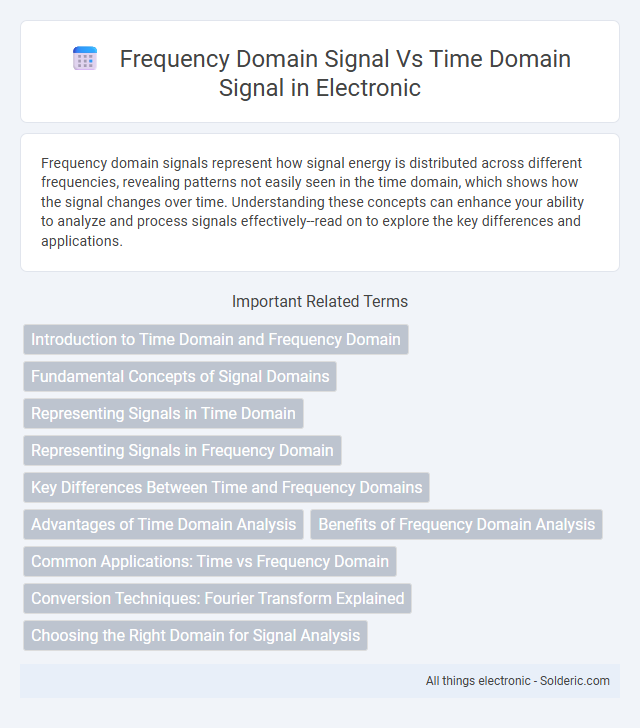Frequency domain signals represent how signal energy is distributed across different frequencies, revealing patterns not easily seen in the time domain, which shows how the signal changes over time. Understanding these concepts can enhance your ability to analyze and process signals effectively--read on to explore the key differences and applications.
Comparison Table
| Aspect | Time Domain Signal | Frequency Domain Signal |
|---|---|---|
| Representation | Signal amplitude vs. time | Signal magnitude and phase vs. frequency |
| Analysis Focus | Temporal changes and waveform shapes | Frequency components and spectral content |
| Applications | Signal duration, transient analysis, time-based events | Filter design, modulation, spectral analysis |
| Tools | Oscilloscope, time domain analyzers | Fourier Transform, spectrum analyzers |
| Data Type | Real or complex-valued time samples | Complex-valued frequency components |
| Information Detail | Exact signal behavior over time | Frequency distribution, harmonics, bandwidth |
| Signal Processing | Time-based filtering, convolution | Frequency filtering, spectral shaping |
Introduction to Time Domain and Frequency Domain
Time domain signals represent how a signal changes over time, showing amplitude variations at each moment, which is essential for analyzing real-time behavior. Frequency domain signals reveal the signal's composition in terms of different frequencies and their amplitudes, providing insight into periodic components and spectral content. Understanding both domains allows you to effectively analyze, process, and interpret signals for applications like communications, audio processing, and system diagnostics.
Fundamental Concepts of Signal Domains
Time domain signals represent variations in amplitude over time, capturing how a signal evolves moment-by-moment. Frequency domain signals decompose these time-based variations into constituent sinusoidal components, displaying the signal as a function of frequency. Fundamental concepts in signal domains involve understanding Fourier transform techniques that convert time domain data into frequency spectra, enabling analysis of signal bandwidth, harmonics, and spectral content.
Representing Signals in Time Domain
Representing signals in the time domain involves plotting signal amplitude as a function of time, showing how the signal varies moment by moment. This approach helps analyze signal behavior directly, revealing features such as transient events, duration, and time-based changes. Your ability to interpret these variations is crucial for applications like audio processing, communications, and control systems.
Representing Signals in Frequency Domain
Representing signals in the frequency domain involves transforming time-domain data using the Fourier Transform, which decomposes signals into their constituent sinusoidal frequencies. This approach enables detailed analysis of signal components such as amplitude and phase across different frequencies, improving filtering, modulation, and spectrum analysis. Frequency domain representation is essential for applications in communications, audio processing, and signal compression, providing insights not readily apparent in time-domain signals.
Key Differences Between Time and Frequency Domains
Time domain signals represent how a signal changes over time, displaying amplitude variations at each time instant, essential for analyzing transient behaviors. Frequency domain signals illustrate the signal's spectral components, revealing the amplitude and phase of each frequency present, crucial for understanding signal composition and filtering. The key difference lies in their perspectives: time domain focuses on signal evolution temporally, while frequency domain emphasizes signal characteristics in terms of frequency content.
Advantages of Time Domain Analysis
Time domain analysis offers intuitive insights into signal behavior by directly observing amplitude variations over time, making it easier to interpret transient events and non-stationary signals. Your ability to quickly identify signal features such as peaks, duration, and waveform shape supports effective diagnosis and real-time monitoring in applications like communication systems and biomedical engineering. This approach also allows straightforward implementation of time-based filters and time-sequenced measurements crucial for dynamic system analysis.
Benefits of Frequency Domain Analysis
Frequency domain analysis enables easier identification of signal components, such as amplitude and phase at specific frequencies, which is challenging in time domain representation. This approach enhances your ability to filter noise, detect periodicity, and perform system characterization with improved accuracy. Engineers frequently rely on frequency domain techniques for signal compression, modulation, and spectrum allocation in communications.
Common Applications: Time vs Frequency Domain
Time domain signals are commonly used in applications such as audio processing, seismic data analysis, and real-time monitoring where signal amplitude variations over time are critical. Frequency domain signals excel in communications engineering, radar systems, and image processing by revealing signal frequency components and enabling filtering or modulation techniques. Understanding the differences allows you to choose the best domain for tasks like noise reduction, signal compression, or spectrum analysis.
Conversion Techniques: Fourier Transform Explained
Fourier Transform converts time-domain signals into frequency-domain representations, revealing the signal's frequency components and amplitudes. This technique enables you to analyze signal behavior in terms of frequency rather than time, crucial for applications like audio processing and communications. Inverse Fourier Transform restores the original time-domain signal from its frequency-domain data, ensuring seamless bidirectional conversion.
Choosing the Right Domain for Signal Analysis
Choosing the right domain for signal analysis depends on the signal's characteristics and the desired insights; time domain signals provide detailed amplitude variations over time, making them ideal for transient or non-stationary signals. Frequency domain signals, represented through Fourier Transform or spectral analysis, reveal periodicities and frequency components crucial for filtering, modulation, and system identification. Engineers often combine both domains to enhance signal processing efficiency in applications like telecommunications, audio processing, and vibration analysis.
frequency domain signal vs time domain signal Infographic

 solderic.com
solderic.com